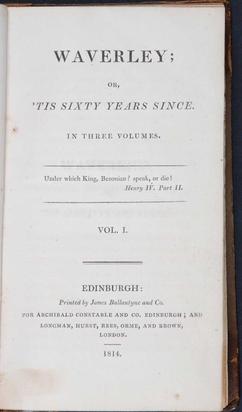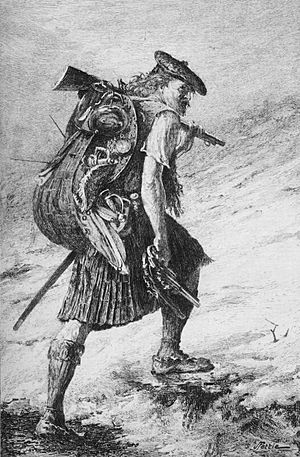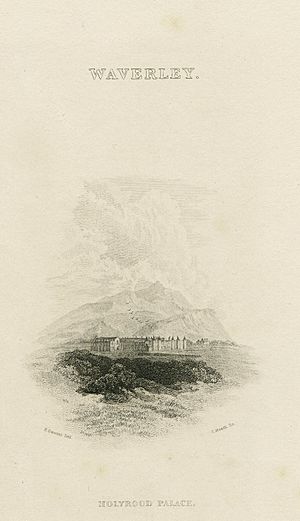Waverley (novel) facts for kids

First Edinburgh edition
|
|
| Author | Walter Scott |
|---|---|
| Country | Scotland |
| Language | English, Lowland Scots; some Scottish Gaelic and French |
| Series | Waverley novels |
| Genre | Historical novel |
| Set in | Scotland, 1745–46 |
| Publisher | Archibald Constable & Co. (Edinburgh); Longman, Hurst, Rees, Orme, and Brown (London) |
|
Publication date
|
7 July 1814 |
| Media type | |
| Pages | 365 (Edinburgh Edition, 2007) |
| 823.7 | |
| LC Class | PR5322 .W4 |
| Followed by | Guy Mannering |
Waverley; or, ’Tis Sixty Years Since is a famous historical novel written by Walter Scott. He was already well-known as a poet. In 1814, he decided to try writing a story in prose. He published Waverley without putting his name on it. Many people think it's one of the very first historical novels ever written in the Western world.
The story follows Edward Waverley, a young English gentleman. His father suggests he join the army just before the Jacobite uprising of 1745. Edward gets a job as an officer. While on leave from his army training, he visits family friends in Scotland. He enjoys their warm Scottish welcome. Edward has a very imaginative mind from all the books he's read. He is surprised to find himself among people who support the return of the House of Stuart royal family. They want Bonnie Prince Charlie (also called the Young Chevalier) to be king.
Edward's honor is often tested as people try to get him to join the Stuart side. He ends up in battles and falls in love with two different women before choosing one. His good manners and actions help him make friends on both sides of the uprising. These friends later help him when his own government puts down the rebellion.
Walter Scott later published his other novels as being "by the author of Waverley." He kept his identity a secret for a long time. In 1818, he became Sir Walter Scott. It was widely known that he was the author of Waverley, but he only publicly admitted it in 1827. His books from this time are now known as the "Waverley Novels."
Contents
How the Story Was Written
Walter Scott started writing Waverley around 1808. He put it aside a few times and finally finished it in 1814. He knew a lot about the Jacobite history. He had even talked to people who were part of the 1745 uprising. He also used many books from his large library to get facts and stories.
Different Versions of the Book
The first version of Waverley came out in three parts on July 7, 1814. It was published in Edinburgh and London. Like all his early novels, Scott didn't put his name on it. Many copies were sold quickly. Scott made small changes to the book for later versions. In 1829, a special 'Magnum' edition was released, which included new notes and an introduction by Scott himself.
The Story of Waverley
Setting the Scene
The story takes place during the Jacobite rising of 1745. This was a time when people wanted to bring back the Stuart royal family, led by Charles Edward Stuart, also known as "Bonnie Prince Charlie." Edward Waverley, a young English soldier and dreamer, is sent to Scotland that year. He travels from his family home in southern England, called Waverley-Honour. First, he goes to the Scottish Lowlands to visit a family friend, Baron Bradwardine. Then, he goes into the Scottish Highlands, where the rebellion is strong.
Edward's Journey
Edward lives comfortably at his uncle's estate, Waverley-Honour. His uncle supports the old Tory party and the Jacobite cause. Edward also spends time with his parents, but his mother dies when he is young. His father works for the Hanoverian government in London. Edward is a man of honor but doesn't have strong political views at first.
His father gets him a job in the Hanoverian army, and Edward is sent to Dundee. After some training, he takes a break to visit Baron Bradwardine, a friend of his uncle. There, he meets the Baron's lovely daughter, Rose.
Wild Highlanders visit Bradwardine's castle, and Edward becomes very curious. He goes to the mountain home of the Clan Mac-Ivor. There, he meets the Chief, Fergus, and his sister, Flora. They are strong Jacobite supporters and are getting ready for the uprising.
Edward stays too long on his leave and is accused of leaving the army and being a traitor. He is arrested, but the Highlanders rescue him. They take him to the Jacobite stronghold at Doune Castle, and then to Holyrood Palace. There, he meets Bonnie Prince Charlie and is very impressed by him.
Encouraged by the beautiful Flora Mac-Ivor, Edward decides to join the Jacobite cause. He fights in the Battle of Prestonpans in September 1745. During the battle, Edward saves the life of a Hanoverian officer, Colonel Talbot, who is a close friend of Edward's uncle. Edward gets separated from Fergus and his group. He finds local people who hide him until it's safe to leave. He reads a newspaper and learns his father has died, so he heads to London.
After the Rebellion
When the Jacobite rebellion fails in 1746, Colonel Talbot helps Edward get a pardon. Edward visits Baron Bradwardine's estate, which has been damaged by soldiers. He finds the Baron and asks to marry his daughter, Rose. Soon, Edward and Rose are engaged. The Baron also receives a pardon.
Edward tries to find Flora the day before her brother's trial. She plans to join a convent in France. Edward then goes to the trial in Carlisle, where Fergus Mac-Ivor is sentenced to death. Edward stays with Fergus in his last hours.
Edward returns to his uncle and aunt at Waverley-Honour to prepare for his wedding. He also makes sure the pardons for himself and the Baron are official. Colonel Talbot's family helps restore the Baron's estate, which was taken from him because of his Jacobite actions. Edward uses money from selling his late father's home to help restore the estate to the Baron.
Main Characters
- Edward Waverley: The main character, a young English gentleman and soldier.
- Sir Everard Waverley: Edward's uncle.
- Cosmo Comyne Bradwardine: A Scottish Baron and friend of Edward's uncle.
- Rose Bradwardine: The Baron's lovely daughter, who Edward falls in love with.
- Fergus Mac-Ivor: A Highland chieftain and strong Jacobite leader.
- Flora Mac-Ivor: Fergus's beautiful and spirited sister.
- Charles Edward, the Young Pretender: Also known as Bonnie Prince Charlie, the leader of the Jacobite cause.
- Colonel Talbot: A Hanoverian officer whose life Edward saves.
Chapter Highlights
Volume One
- Chapter 1-5: Edward's Early Life: The story introduces Edward Waverley. We learn about his family, his uncle Sir Everard, and his unusual education. He loves reading, which makes him very imaginative.
- Chapter 6-7: Joining the Army: Edward gets a job in the army. He finds military life boring and gets permission to visit Scotland.
- Chapter 8-14: Tully-Veolan: Edward arrives at Baron Bradwardine's home, Tully-Veolan. He meets Rose and learns about the Baron's old-fashioned ways.
- Chapter 15-23: The Highlands: Edward travels into the Highlands. He meets the wild Highlanders and then Fergus and Flora Mac-Ivor. He is fascinated by their way of life.
Volume Two
- Chapter 24-27: News and Decisions: Edward gets injured and receives news from England. His father has political problems. Edward resigns from the army. Flora tells him she can't marry him.
- Chapter 28-38: Trouble and Rescue: Edward is suspected of being a Jacobite. He gets into trouble and is arrested. Highlanders rescue him.
- Chapter 39-47: Joining the Jacobites: Edward is taken to Edinburgh and meets Bonnie Prince Charlie. He decides to join the Jacobite army. He fights bravely in the Battle of Prestonpans and saves Colonel Talbot.
Volume Three
- Chapter 48-56: After the Battle: Edward helps Colonel Talbot, who is now his prisoner. He learns more about the political tricks that got him into trouble. Edward starts to feel more for Rose.
- Chapter 57-61: Challenges and Losses: Fergus is angry with Edward. Edward faces a skirmish and learns his father has died. He travels to London.
- Chapter 62-65: Pardons and Discoveries: Colonel Talbot helps Edward get back to Scotland safely. Edward finds Baron Bradwardine hiding. He learns that Rose helped rescue him earlier.
- Chapter 66-72: Happy Ending: Edward and the Baron receive royal pardons. Edward and Rose get married. The Baron's estate is restored, and everyone celebrates.
Main Ideas in the Book
Fairness and Understanding
Walter Scott believed that all people are good, no matter their background, religion, or politics. A big idea in his books is tolerance, meaning being fair and understanding towards others. He thought society should move forward but still respect old traditions. Scott was one of the first writers to show everyday people like farmers, merchants, and soldiers in a kind and real way.
Heroines in the Story
In Scott's novels, there are often two types of main female characters. One is usually blonde, calm, and sensible. She often marries the hero at the end. The other is usually dark-haired, more passionate, and follows her feelings.
In Waverley, Rose is the sensible, marriageable type. Flora is the passionate, strong-willed type. Scott shows that even though the heroes might not always notice, his female characters have deep thoughts and feelings.
Some people think Flora represents the old ways of Scotland, while Rose represents a more modern, logical Scotland after the union with England.
Humor in the Story
While some parts of Waverley can seem serious, Scott also included humor. He sometimes made fun of old traditions or silly situations. For example, he compares the new, less-than-perfect recruits joining the Jacobite army to the desperate followers of David in the Bible story of the Cave of Adullam.
Fear of Conflict
The story shows how scary and damaging a civil war can be. The division in Edward's own family came from an earlier English Civil War. The fear of conflict is always present in Waverley, showing how deeply Scott felt about it.
Places and Things Named After the Novel
Waverley was so popular that many places and things were named after it!
- Waverley Station in Edinburgh, Scotland, is named after the novel. So are nearby streets like Waverley Park.
- Several paddle steamers have been called Waverley, including the famous PS Waverley that still sails today.
- Waverly Place in Greenwich Village, New York City, was named after the novel in 1833.
- The Waverley Pen, a type of pen nib, was named after the novel in 1850.
- The town of Waverley, New Zealand, and many towns in the United States like Waverly, Iowa and Waverly, Ohio, also got their names from the book.
- In Australia, the suburb of Waverley, Sydney and nearby Glen Waverley and Mount Waverley in Melbourne are named after the novel.
Interesting Facts
- The character of Fergus Mac-Ivor was based on a real person, Alexander Ranaldson MacDonell of Glengarry, a very colorful Highland chieftain.
- The idea that "Scott is the author of Waverley" was used by a famous philosopher, Bertrand Russell, to explain ideas about language and meaning.
- The character of Davie Gellatley, who is described as a "fool," is thought to be based on a real person known as Jamie Fleeman, the Laird of Udny's Fool.




